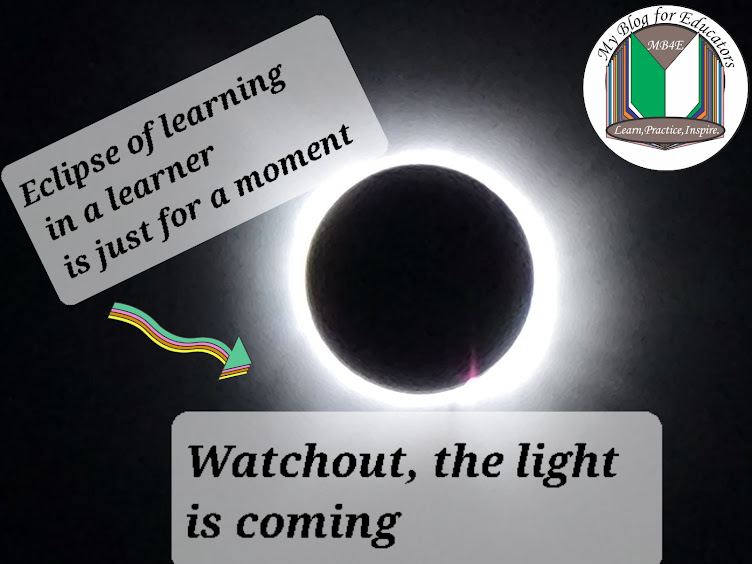Always a Life-Long Learner By Maia Reed-TEDx (Lakeland University)
Life-long learning is a must-have for teachers. It is a
special gift one can give to him or herself. Let us get that straight. Being
comfortable at the level you began your teaching journey is not a great
decision. As soon as you make lifelong learning a primary factor in your life,
you will soar.
This type of learning is beyond school, it is a
conscious effort by one to improve. To stop learning is destructive to personal
growth and development. As teachers, we cannot thrive in the profession without
constantly learning.
Being a lifelong learner indicates that you love the
profession and that you are ready to equip yourself for authentic teaching. Not
being a lifelong learner can be disadvantageous to yourself and the learners
you are handling. Therefore, make a conscious effort to become one. It is
voluntary but, it is a necessity if you want to remain relevant in any
profession, not just teaching. Find a positive way to foster continuous growth
and development in your life. Do not be rigid, get out of your comfort zone.
Yes, we are busy, no doubt about that. Personal,
family, work, all of those, but then special attention should be paid to
personal growth and development through lifelong learning. It will be woefully
inadequate to live a life devoid of learning as a teacher because, under the
standard of teaching and learning, your skill will be inadequate when set
against the demands of effective teaching.
Let us even look at the meaning of lifelong learning
According to Dictionary .com, lifelong learning is the
'provision or use of both formal and informal learning opportunities throughout
people's lives in order to foster the continuous development and improvement of
the knowledge and skills needed for employment and personal fulfillment'
Albert Einstein sees lifelong learning as life, no
wonder he said in his quote,
"Once you stop learning, you start dying."
This quote reflects the pressing need for lifelong learning in today's world.
It goes beyond having degrees in formal school, it involves a personal decision
to improve even outside the parameters of formal education
We are in the digital age, everything is changing and
we have to build the skills and awareness that are required to adapt properly.
That can only be achieved if we continue to learn and not quit.
Lifelong learning is a process that should continue
throughout a lifetime. It does not have an expiry date as long as you are
alive.
Remember, ''The illiterate of the 21st century will
not be those who cannot read and write, but those who cannot learn, unlearn,
and relearn.'’-----Alvin Toffler
Thinking about the benefits of being a lifelong
learner, here are some tips
Life-long learning helps to address your learning needs
It enables a teacher to be ready to meet the needs of
the changing world.
It helps you to improve the quality of your life and
self-worth.
Lifelong learning offers you the opportunity to
explore, learn, and grow (it helps you to keep abreast).How do you feel when
you know that you know? Confident right
With life-long learning, you acquire skills that will
help you to adapt to the changing technology in your workplace. You can learn a
skill or improve on the existing ones
It increases your employability and earns you more
money
Wondering how to be a lifelong learner, check out
the tips
This is a busy world, so we try to balance personal,
work, family, social life and so on:
·
Know what works for you- Identify your learning
style, and know the best time to study.
·
Create an workable time management table
·
Self-taught learning- whether reading from the
book (print or e-books), listening to audio, video, and so on
·
Attend workshops, seminars, and trainings. Do
not be a resistor
·
Collaborate with your colleagues, Do not be an
island
·
Ask questions, it is amazing the kind of
knowledge we gain when we ask questions
·
Visit credible sites and blog posts
·
Sign up for newsletters from credible
educational institutions and sites
·
Belong to subject-based associations. For
example, a biology teacher who belongs to the National Association of Biology
Teachers (NABT). Most of these organisations organise incredible workshops and
professional development conferences that will add immensely to your growth
·
Get a Coach, Mentor, or Accountability partner
·
Go back to school if you need to
Any disadvantage of refusing to be a lifelong
learner as a teacher? I only know a big one, you will be obsolete with time and your
services will no longer be needed.
Take ownership of your personal growth and development.
Be determined . Do not waste time because the world is changing, and technology
is advancing.
Additional resources
How to build lifelong learning skills for the 21st Century workplace


.jpeg)



